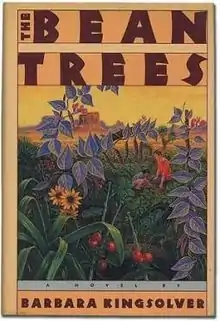The Bean Trees
The Bean Trees is the first novel by American writer Barbara Kingsolver, published in 1988 and reissued in 1998. It was followed by the sequel Pigs in Heaven. The protagonist of the novel is named Taylor Greer, a native of Kentucky. She sets out to leave home and travel west, and finds herself in Oklahoma near Cherokee territory. As Taylor stops in the town, a woman suddenly approaches, deposits a small child, and leaves with no further explanation. Not knowing what else to do, Taylor decides to care for the child. The novel traces the experiences of Taylor and the child, who Taylor names Turtle. Covering Turtle's early childhood, the story includes a colorful cast of characters: Lou Ann, her roommate; Esperanza and Estevan, a Guatemalan couple; and Mattie, the owner of "Jesus Is Lord Used Tires".
 First edition | |
| Author | Barbara Kingsolver |
|---|---|
| Country | United States |
| Language | English |
| Genre | Dramatic Fiction |
| Publisher | Harper & Row |
Publication date | 1988 |
| Media type | Print (hardback & paperback) and audio-CD |
| Pages | 232 |
| ISBN | 0-06-015863-8 |
| OCLC | 16900347 |
| 813/.54 19 | |
| LC Class | PS3561.I496 B44 1988 |
| Followed by | Pigs in Heaven |
Themes
The novel makes reference to the issue of Native American parental rights. At least one reader, familiar with Native American adoption rights, thought that the sequel, Pigs in Heaven, was written to correct misconceptions in the first book by Barbara Kingsolver. Themes of love and nurturing emerge from the violence and poverty that the characters face. The book conveys multiple symbolic meanings about shared motherhood, life and death, and beauty. The underlying themes not always recognized include those about mockery toward the judicial system, the flawed coping strategies of current day issues, and the strength of friendship.
Reception
The novel was well received by critics and has become commonly assigned reading in high school literature classes. Jack Butler wrote for the New York Times, "The Bean Trees is as richly connected as a fine poem, but reads like realism."[1]
References
- "Specials". www.nytimes.com. Retrieved 2014-10-11.